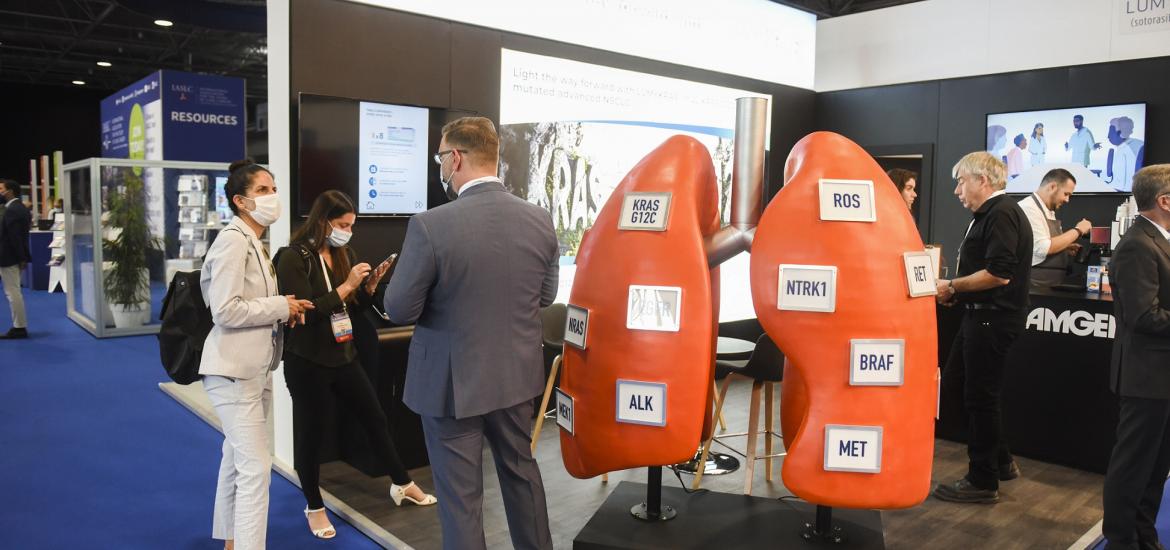
World Lung 2024 – Lilly eyes a first-line KRAS triplet
Data suggest a path forward for olomorasib plus Keytruda and chemo in PD-L1 low and negative patients.
Data suggest a path forward for olomorasib plus Keytruda and chemo in PD-L1 low and negative patients.

Combining KRAS G12C inhibitors with checkpoint blockers has been tricky enough, but Lilly is attempting to go even further. Data presented on Monday at World Lung suggest that there might be a future for a triplet comprising the group’s KRAS contender olomorasib plus Keytruda and chemo.
A 50% overall response rate in a phase 1 first-line NSCLC cohort was described as “excellent” by the discussant, Professor Caicun Zhou of Shanghai East Hospital – particularly as the vast majority of patients were PD-L1 low or negative. However, toxicity was significant, with high rates of grade 3 cytopenias.
This had some in the audience questioning the design of Lilly’s phase 3 first-line NSCLC trial, Sunray-01, which has two sections: part A testing olomorasib plus Keytruda in PD-L1-high patients (≥50%); and part B evaluating a chemo-containing triplet in all comers.
Dr Tony Mok of the Chinese University of Hong Kong asked why Lilly hadn’t restricted part B to those with 1-49% PD-L1 expression, to save high expressers from unnecessary toxicity. The group is the only big player testing a triplet in its first-line pivotal trial, with rivals like Bristol Myers Squibb and Merck & Co focusing on KRAS G12C/Keytruda combos in PD-L1-high patients.
Roche, meanwhile, has yet to reveal its first-line intentions, with a phase 3 trial of divarasib slated to start next year in this setting. In the meantime, the company is evaluating divarasib plus Keytruda and chemo as part of its phase 1/2 front-line study, Krascendo-170. Data are due this year or in 2025 and, if positive, could lend support to this approach.
Front-line doublet or triplet
The jury is still out on whether a doublet or triplet approach will be best.
On the face of it, the 50% ORR reported with olomorasib/Keytruda/chemo at the World Conference on Lung Cancer fell short of the 77% seen with an olomorasib/Keytruda doublet at ASCO this year. Both readouts, in first-line NSCLC, concerned different cohorts of the same phase 1/2 trial, LOXO-RAS-2001.
However, it should be noted that 43% of patients in cohort B9, testing the triplet, were PD-L1 low (1-49% expression), and 48% were PD-L1 negative (<1%).
By contrast, just over half of patients in cohort G, which evaluates olomorasib plus Keytruda, were PD-L1 low or negative.
As a benchmark of sorts, the Krystal-7 first-line study of Bristol Myers Squibb’s Krazati plus Keytruda in first-line disease reported an ORR of 63% – but in patients with PD-L1 ≥50%.
As for adverse events, high-grade treatment-related cytopenias were common with olomorasib/Keytruda/chemo: 24% and 19% of patients suffered grade 3 or greater neutropenia and anaemia respectively. On the plus side, rates of liver enzyme elevations were low; this side effect scuppered Amgen’s plans for a Lumakras/checkpoint inhibitor combo, and that group is now focused on Lumakras plus chemo in first-line NSCLC.
Divarasib threat
Roche’s aforementioned divarasib also featured at World Lung, but in second-line NSCLC, where it was tested both with and without Tecentriq.
The Tecentriq combo data look disappointing: it’s worth noting that a sizeable chunk of patients had previously received KRAS G12C inhibitors, but even excluding these ORR was 56%, in line with divarasib monotherapy.
Overall, though, these data, as well as results with two Chinese KRAS G12C inhibitors, garsorasib and fulzerasib, could have Amgen and Bristol looking over their shoulders.
Zhou noted that randomised controlled trials of the newcomers are needed, and Roche has signalled its confidence here, recently starting the phase 3 Krascendo-1 trial testing divarasib head-to-head against Lumakras and Krazati in second-line lung.
Whether garsorasib and fulzerasib could be approvable outside of China is another question; last month, the latter became the first KRAS G12C inhibitor to get the NMPA's green light in China, in second-line NSCLC.
There are also doubts about the size of the KRAS G12C market, particularly in the second line: Krazati sold just $53m in the first half of 2024.
Cross-trial comparison of KRAS G12C inhibitors in 2L NSCLC
| Project | Divarasib | Divarasib + Tecentriq* | Garsorasib | Fulzerasib | Lumakras | Krazati |
|---|---|---|---|---|---|---|
| Company | Roche | InventisBio | Genfleet/ Innovent | Amgen | Bristol Myers Squibb | |
| Study | Ph1 global trial | China ph1/2 | China ph2 | Ph1/2 Codebreak-100 | Ph1/2 Krystal-1 | |
| N | 65 | 38 | 123 | 116 | 174 | 112 |
| ORR | 56% | 42% | 52% | 49% | 41% | 43% |
| mPFS (months) | 13.8 | N/A | 9.1 | 9.7 | 6.3 | 6.5 |
| mOS (months) | N/A | N/A | 14.1 | N/A | 12.5 | 12.6 |
Note: *allowed prior KRAS G12C inhibitor therapy. Source: IASLC & OncologyPipeline.
1279













